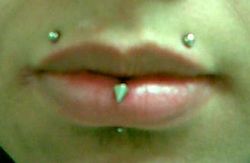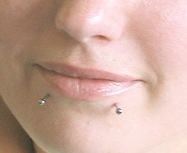Lip piercing
| Lip piercing | |

| |
| Nicknames | |
| Location | |
| Jewelry | |
| Healing time | 6 to 8 weeks |
- This article is about Piercings
A Lip piercing is a type of body piercing which penetrate the lips, or the area surrounding the lips. The lips and surrounding area can be pierced in a variety of ways.
Healing and initial jewelry
Approximate healing times for most lip piercings are between six to eight weeks. After this time, some scar tissue may be present, but the fistula is normally fully developed and mostly healed. Aftercare consists of saline soaks two to three times daily. Soaking the wound for three to five minutes with a weak saline solution softens any blood and lymph discharge attached to the jewellery. Using a cotton swab or q-tip removes excess matter from the site. Afterward, one should slowly turn the jewellery through the piercing, rinse with saline solution to flush the inside of the wound and remove any matter remaining in and around the piercing.
Alcohol-free mouthwash can also be used after meals to help remove debris and flush the piercing, and is recommended by some practitioners.
Initial jewellery should be either a labret stud (flat-backed barbell) or a ball closure ring, manufactured from high-grade surgical stainless steel, implant-grade titanium or similar lightweight and inert metal. No matter which type of jewellery is used (Labret Stud or ball closure ring), the jewellery's diameter/length will be intentionally oversized to allow room for initial swelling. After healing, the jewellery can be replaced with a closer-fitting piece.
Overall, lip piercings are easy and quick to heal considering proper aftercare and common sense is adhered to.
Health issues
Most lip piercings have the potential to damage both teeth and gums. A home-made saline solution is a common way to heal a lip piercing and avoid infection. Combine one-fourth teaspoon of all natural pink or gray non-iodized sea salt to one cup of distilled or filtered water. This solution can be used to rinse out the mouth after eating (or mouth can be rinsed with non-alcoholic, non-microbial mouth wash) and soak the outside of the piercing using a cotton ball. Anything with alcohol, peroxide, iodine, or any strong soaps should be avoided because they may irritate the fresh piercing, and cause additional swelling and trauma during the healing process. Also using things like peroxide, iodine, teatree oil, conventional antibacterial soap, or dish soap can damage or kill the skin in and around the piercing extending the healing process. The ornament should be periodically cleansed to prevent bacterial plaque and calculus accumulation.
Types of lip piercings
Lip piercings can be placed anywhere around the mouth, but the surface of the lip is not typically pierced itself, except for horizontal lip piercings and canine bites. Piercings in specific positions have certain names:
- Monroe piercings are labret studs worn on the upper lip where Marilyn Monroe had her famous mole. This piercing is also known as the Madonna piercing in some circles.
- Medusa piercings go through the center of the upper lip (the philtrum), perpendicular to the tissue.
- Labrets are pierced with a labret stud. A flat disc sits between the back of the lip and the gums and a bead sits on the outside of the lip. Labrets can pierced in the center or off-center. A variation of this is the lowbret, a lower labret.
- Vertical labrets go through the center of the bottom lip, parallel to the tissue. The variation is called the vertical lowbret, which starts inside the mouth between the lower lip and the teeth (not behind the teeth as with a mandible piercing) and travels straight down, exiting on the lower edge of the jawline.
- Horizontal lip piercings are a horizontal bars on the lower lip that go through the lip surface. This is a very rare piercing.
Bites
"Bites" is a term for sets of lip piercings placed in certain ways. There are many types:
- "Angelbites" or "Antibites" are two upper lip piercings on opposite sides of the mouth. They are sometimes made up of two Monroe piercings
- "Snakebites" are two lower lip piercings on opposite sides of the mouth.
- "Viperbites" are two lower lip piercings that are closely placed side by side.
- "Caninebites" are four piercings directly through the lip, one on each side of the mouth. In other words, the act of getting both "Angelbites" and "Snakebites".
- "Spiderbites" are two, right next to each other on either the left, right or both sides of the lip
- "Cyberbites" are when the middle labret piercing and the medusa piercing are combined
History and culture
Lip piercing continues to be practiced by many people, the most well-known of which are certain African tribes, who wear large decorative lip plates or discs, usually in the lower lip.
In contemporary society, lip piercings are relatively common piercings, especially amongst youths. In a study among Israeli young-adults, 4.3% had present or past body piercing (not included earlobe, lip or intra-oral piercing), and 5.7%, 6.2% and 15.7% had present or past lip piercing, body tattooing and intra-oral piercing, respectively.
See also
- Body piercing
- Body piercing aftercare
- Body piercing jewelry
- Tongue frenulum piercing
- Tongue piercing
External links
| Articles related to Piercings | |
|---|---|
| Piercing methods | Contemporary piercing procedures • Body piercing materials • Stretching • Play piercing • Pocketing • Surface piercing |
| Ear piercings | Tragus • Antitragus • Snug • Daith • Conch • Helix • Rook • Industrial |
| Facial and oral piercings | Cheek • Eyebrow • Anti-eyebrow • Lip (Labret) • Lip plate • Lip frenulum • Monroe • Medusa) • Nose (Bridge) • Tongue (Tongue frenulum) • Uvula |
| Body piercings | Corset • Hand web • Madison • Navel • Nipple • Nape |
| Female genital piercings | Christina • Clitoris • Clitoral hood • Triangle • Fourchette • Isabella • Labia • Nefertiti • Princess Albertina |
| Male genital piercings | Ampallang • Apadravya • Hafada • Foreskin • Deep shaft • Dolphin • Dydoe • Frenum • Frenum ladder • Guiche • Lorum • Magic Cross • Prince Albert • Reverse Prince Albert • Pubic • Transscrotal |
Chat rooms • What links here • Copyright info • Contact information • Category:Root
